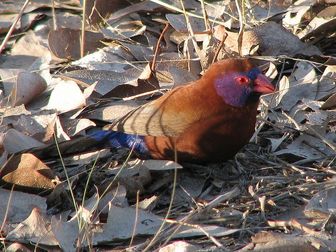Violet-eared Waxbill
It is found in subtropical/ tropical dry shrubland and savanna habitats in Angola, Botswana, Mozambique, Namibia, South Africa, Zambia and Zimbabwe. The status of the species is evaluated as Least Concern.

Original source: Violet-eared Waxbill on flickr
Author: Alastair Rae
The Violet-eared Waxbill is classified as Least Concern. Does not qualify for a more at risk category. Widespread and abundant taxa are included in this category.
the Violet-eared Waxbill, has excellent photographs and assists the visitor in gaining perspective on the Violet-eared waxbill's origins and relationship to other waxbills. Background Information including geographic origins and description (scroll down). Elaine Miller Aviary's General Care & Supplies Article emphasizes the violet ears' need for mealworms and insects. More
The Violet-Eared Waxbill must have a daily ration of insects, ants' eggs, grubs and mealworms. Mixed millets and plain canary seed, millet sprays and some greenfood should also be provided, and grit and cuttlefish bone must always be available. Try to provide as varied a diet as possible. This species needs extra care in cold weather and sometimes a little extra warmth. It should be protected from sudden changes in temperature. More
also a picture of the Violet-eared Waxbill on page 1057. The Violet-eared Waxbill belongs to the family of birds classified as Estrildidae. According to the Percy FitzPatrick Institute of African Ornithology the Violet-eared Waxbill is also known by these other names: Grenadier, Purple Grenadier, Common Grenadier, Violet-eared Cordon-Bleu. In the previous edition of Roberts (ie 6th edition) the Violet-eared Waxbill was called the . More

Original source: Flickr user Alastair Rae . Photo uploaded to commons by user ltshears
 Passeriformes
PasseriformesFamily : Estrildidae
Genus : Uraeginthus
Species : granatinus
Authority : (Linnaeus, 1766)
